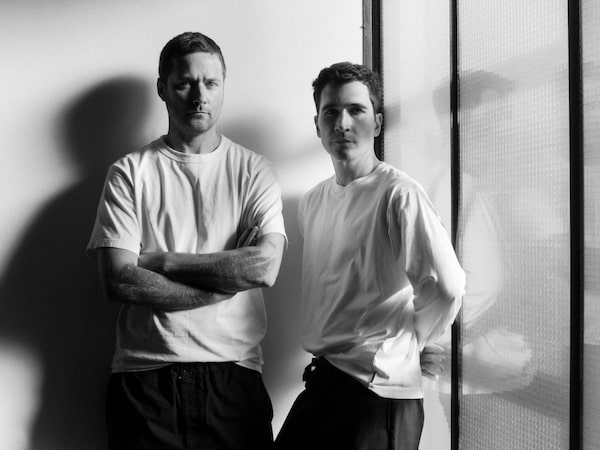
Proenza Schouler was co-founded by Jack McCollough and Lazaro Hernandez.Norman Wong/Handout
For many young women at the turn of the millennium, Proenza Schouler defined New York cool. Founded in 2002 by then Parsons students Jack McCollough and Lazaro Hernandez, the label achieved success early on, winning the inaugural CFDA/Vogue Fashion Fund in 2004, lining the racks at trendsetting retailers such as Barneys and becoming a favourite of fashionable It girls including the Olsen twins.
Best known for the PS1 satchel, Proenza Schouler has matured into a glamorous brand while still retaining its signature Big Apple edge. While visiting Toronto to host an intimate trunk show and soirée, Hernandez and McCollough spoke with The Globe and Mail about their evolution, connecting with clients and where they’re headed next.
You’re in Toronto for a trunk show. How are these intimate events different from the big runway productions and celebrity dressing you’ve done in the past?
Lazaro Hernandez: “We still do our big runway shows, we still work with celebrities. We’re doing a little bit more person-to-person stuff these days. We find it’s just invaluable getting to meet with the customer, talking to women, hanging out with them, finding out who’s buying the clothes in all of these different cities, just understanding the market.”
Your label turns 20 this year. How have your designs evolved over the past two decades?
LH: “When we started, we were 19 years old. The clothes were much more going-out, party clothes. As we’ve grown up, all those friends have children now or have matured into their careers and are just really busy in a different way. The woman has evolved with us.”
Jack McCollough: “We still make some of that stuff but I think we’re just addressing more facets of our woman’s life in many ways. It’s really interesting to meet the fans and the customers because it’s a totally different point of view from how we think about clothes and how we design clothes. If you just surround yourself with models all the time, you’re going to make very specific kind of clothes. We always find it very inspiring meeting the customers.”
And our needs are changing again – I think we’re finally done with sweatpants.
JM: “Everyone’s ready to put to bed this COVID living.”
You were so young when you started. What have been some of the most meaningful moments to you over the years?
JM: “Obviously the beginning of our career. We were just pinching ourselves that Barneys picked up our senior thesis collection.”
LH: “That people cared.”
JM: “That was an incredible moment that we still look back on all the time. It put us on the map. I always love seeing people just on the fly wearing our clothes, especially on the street. Another really special moment was going to Paris for a couple of seasons and showing over there. It just gave us a different perspective.”
LH: “Every CFDA Award that we’ve won has been an amazing moment. The first designer of the year we won [in 2007], we shared it with Oscar de la Renta. And that felt a lot like the passing of the baton from one generation to the next. That was really cool. He was always so kind and so sweet to us and helped us out a lot.”
How did the pandemic help you to slow down and take stock?
LH: “We had a show every season for the last almost 20 years. We were doing 20 collections a year. It’s a lot. During COVID, we were just in the house in the country. We were doing collections from there and we were really proud of the clothes. The clothes were working on a business level and even on a press level. And we were like, why can’t we just turn the volume down a little bit and give ourselves a little bit more of a private life again instead of just working all the time?”
JM: “The interesting thing creatively speaking about COVID is that we weren’t having shows, but we were still putting out collections, so we were approaching and thinking about collections in a very different way. We didn’t feel like we had to create these clothes to put on a spectacle of any kind. It was really just focused on who our woman is, what does she want to wear, and what’s the right feeling in the air for such a weird – I hate this word – unprecedented time.”
What are some of the things you’re excited to be doing now that the fashion industry has become more flexible?
LH: “The idea of how to put out a collection is evolving. We were doing the show thing for a long time and then we stopped for two seasons during the pandemic and now we’re definitely back, but that’s not to say that we’re going to keep doing that every season. We want to be a little looser with how we put out collections.”
JM: “These rules about how things are meant to be done have been completely erased the last couple of years. It’s not about doing what everyone else is doing. It’s about doing what makes sense for us and our business.”
This interview has been condensed and edited.